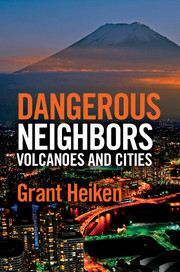Book contents
- Frontmatter
- Contents
- Preface
- Miscellaneous Frontmatter
- Introduction – dangerous neighbors: volcanoes near cities
- 1 Too many people and too many volcanoes – Naples, Italy
- 2 A full menu of volcanic hazards – Mexico City
- 3 “Like dangerous, yet undeniably beautiful women” – Guagua Pichincha and Cotopaxi volcanoes near Quito, Ecuador
- 4 Dangerous neighbors, but some bring gifts – Manila megacity, Philippines
- 5 “It’s part of the culture. Live with it!” – cities in Japan
- 6 Volcanic and proud of it – Auckland, New Zealand
- 7 Coffee, software, aircraft, and volcanic mudflows – Seattle, Tacoma, and Portland, USA
- 8 A tale of two cities – Akrotiri (island of Santorini, Greece) and Plymouth (island of Montserrat, Caribbean)
- 9 The dangerous neighbor is restless – how should a city respond?
- Recommendations for further reading
- Acknowledgements
- Index
9 - The dangerous neighbor is restless – how should a city respond?
Published online by Cambridge University Press: 05 October 2013
- Frontmatter
- Contents
- Preface
- Miscellaneous Frontmatter
- Introduction – dangerous neighbors: volcanoes near cities
- 1 Too many people and too many volcanoes – Naples, Italy
- 2 A full menu of volcanic hazards – Mexico City
- 3 “Like dangerous, yet undeniably beautiful women” – Guagua Pichincha and Cotopaxi volcanoes near Quito, Ecuador
- 4 Dangerous neighbors, but some bring gifts – Manila megacity, Philippines
- 5 “It’s part of the culture. Live with it!” – cities in Japan
- 6 Volcanic and proud of it – Auckland, New Zealand
- 7 Coffee, software, aircraft, and volcanic mudflows – Seattle, Tacoma, and Portland, USA
- 8 A tale of two cities – Akrotiri (island of Santorini, Greece) and Plymouth (island of Montserrat, Caribbean)
- 9 The dangerous neighbor is restless – how should a city respond?
- Recommendations for further reading
- Acknowledgements
- Index
Summary
When discussing potential volcanic eruptions and the risks that they represent to nearby communities, volcanologists have a wealth of examples from which to choose. No matter what the criteria, any ardent volcanologist is sorry to leave out favorite and fascinating examples. One approach is to reduce the number by selecting a few of the largest cities that will be most likely to experience severe consequences. And to further pare the number by describing the neighboring volcanoes about which the most is understood. And then to focus on several volcanoes that are still active. And especially to contrast those for which some mitigation strategies are already in place and those for which it will be very difficult to do so.
Mount Pinatubo’s eruption in 1991 is a recent example that stands out for several reasons: the event took place after a 500-year hiatus; the eruption occurred as the world watched; and a multi-national, multi-disciplinary team monitored the precursor behavior and helped predict the volcano’s progress. Effective visual communication and disaster-awareness materials were used in real time to help decision-makers communicate unwelcome but vitally important and realistic facts to the residents. Since the eruption, education programs undertaken in the Philippines have resulted in increased public awareness.
- Type
- Chapter
- Information
- Dangerous Neighbors: Volcanoes and Cities , pp. 165 - 179Publisher: Cambridge University PressPrint publication year: 2013



